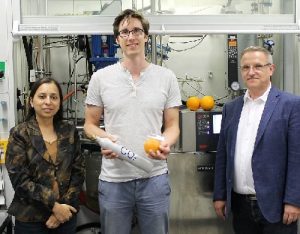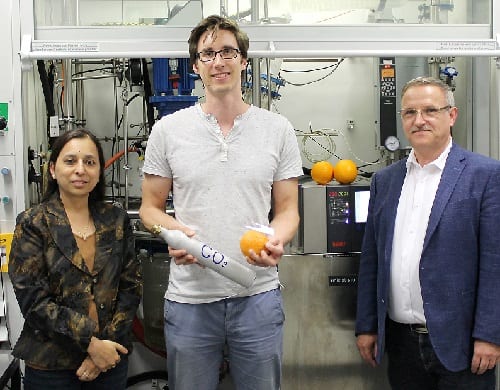Take orange peel, extract the natural substance limonene, oxidize it and connect it with carbon dioxide, and what is produced is a biobased plastic, the basis for various industrial applications without high costs. PLimC, for poly(limonene carbonate), is the name of this green all-rounder that scientists from the University of Bayreuth, Germany, have produced.

Prof. Dr. Seema Agarwal, Oliver Hauenstein and Prof. Dr. Andreas Greiner (from left to right); a reactor for polymer synthesis behind. Photo: Christian Wißler
The polycarbonate results from a synthesis of limonene with carbon dioxide. This ensures that it does not contain the harmful substance bisphenol A, in contrast to conventional polycarbonates. In addition, the new bio-based plastic has a number of properties that makes it attractive for industrial applications: PLimC is rigid, extremely heat-resistant and transparent; therefore it is particularly suitable as a material for coatings.
“These findings, which we published in the previous year, we could now significantly expand in our new study,” explains Prof. Dr. Andreas Greiner, head of the Bayreuth research team. “We showed some concrete examples that PLimC is outstandingly suitable as a raw material.”
Example of such new PLimC-based plastics are antimicrobial polymers, which are capable of preventing an accumulation of E-coli bacteria. As materials for containers, which are used in the medical treatment and care, they can significantly reduce the risk of infection. Also for the production of plastic implants such polymers can be interesting.
Another example is sea water-soluble polymers that dissolve in the salty sea water into ecologically harmless components, and then decompose. Such plastics may – if they are used for bottles, bags or other containers – counteract the dramatic increase in pollution from non-soluble plastic particles.
“Developing new PlimC-based materials the possibilities show almost no limits,” says Oliver Hauenstein, who has done decisive research for the synthesis and application of this new plastic. “The production of PLimC is easy to handle and very environmentally friendly. The peeling waste from orange juice producing companies can be recycled. The greenhouse gas CO2 can be used before it escapes into the atmosphere. In addition, the various PLimC plastics can be easily synthesized without considerable technical or financial efforts. They are ecologically harmless and recyclable.”

















